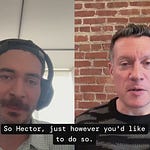When I started The Community Codebreakers series, I wanted to learn from community leaders working in all kinds of spaces, including the ones outside my own experience. I’ve built communities in SaaS, productivity, and more, but never in the world of faith-based communities. Jason Stone from Logos brings a perspective that most of us in GTM or tech rarely hear. His work is a great reminder that while every audience has its own culture and context, the fundamentals of good community building are universal.
You can watch our full conversation in the video above or read on for highlights and takeaways.
Jason’s path into community leadership wasn’t traditional. He earned a master’s degree in biblical exegesis and expected to spend his career in teaching or ministry. Along the way he discovered Logos, a research tool used by pastors, theologians, and scholars. He began sharing tips and support through Facebook groups and newsletters, which eventually led to a role in marketing. Over time Jason transitioned into community leadership, helping Logos evolve from a collection of legacy forums into a modern, connected community.
Turning a legacy forum into a living community
When Jason took on his new role, Logos already had more than twenty years of forum history. It was an incredible resource for user-to-user support but not yet a true community. He led the migration of that system to Higher Logic Vanilla, a move that gave the company a chance to rethink what community could mean for its users.
Instead of focusing only on troubleshooting, Jason wanted to make the experience about connection and learning. His team added an events calendar, built product feedback loops, and introduced AI-suggested answers to help members find relevant information faster. These steps transformed the space from a traditional forum into a place people wanted to visit regularly, not just when they needed help.
He also consolidated multiple user portals, including support, feedback, and the knowledge base, into one hub at community.logos.com. That small but strategic change made it much easier for members to find answers, share feedback, and stay involved.
Balancing passion, structure, and internal alignment
Faith-based communities come with unique dynamics. Theological conversations can turn passionate quickly, and moderation requires both empathy and structure. Jason relies on a long-standing volunteer group called MVPs (Most Volunteer Posts) to help monitor discussions and keep conversations healthy. These volunteers are essential partners who help identify issues early and maintain a respectful environment.
One story he shared stood out. A member posted a heated message that crossed the line. Jason had to step in and issue a temporary ban, which turned into a weekend-long email exchange. The member eventually returned to post a public apology. The community responded with understanding and encouragement. Jason saw this as a defining moment. “That’s the difference between a forum and a community,” he said.
Internally, Jason has been working to help others at Logos understand the strategic role of community. He created clear escalation paths, launched a company-wide Slack space called “Ask Community”, and started regular reporting updates to share key metrics and insights. These consistent touchpoints helped shift perceptions inside the company, moving community from a support function to a cross-functional program that drives connection, feedback, and learning.
Making community everyone’s business
At Logos, the community function sits within the customer success organization. That structure fits naturally but also introduces competing priorities. Marketing wants visibility, product wants feedback, and CS wants faster answers. Jason’s approach is to stay transparent about what the community can realistically deliver while keeping the focus on outcomes that support customers.
His primary metrics tie back to customer success, such as faster response times and increased satisfaction. He also tracks secondary signals like engagement, churn risk, and how often users reference the community during support interactions. By connecting these dots, he helps other departments see how community strengthens the broader customer journey.
He also makes collaboration an ongoing process. Jason works closely with product, support, and marketing leaders to ensure community insights feed into decision-making. His internal “roadshow” updates keep everyone informed and invested, showing that community is not a side project. It is a critical part of how Logos serves and learns from its users.
Why he does this work
When I asked Jason what keeps him motivated after wearing so many hats—educator, marketer, and community manager—his answer was immediate. It’s the people. He shared a story about two users who met through the Logos community, became friends, and eventually introduced their families to each other. To Jason, that story captures the real value of this work.
“I’ve done social and SEO, but those things can feel transactional,” he told me. “Community is life-giving. It changes people.”
That sense of connection and shared purpose is what drives him. The product may be the starting point, but the relationships people build around it are what make the work meaningful.
Key Takeaways
Community programs can evolve at any stage, even in long-established organizations.
Volunteer leaders are powerful partners when they’re supported with clear roles and recognition.
Internal storytelling builds credibility. Share community wins across the company to make the impact visible.
Replatforming is an opportunity to redesign how people connect, not just move data.
Cross-functional alignment requires clarity. Define what community is, and what it is not, so others don’t define it for you.
Empathy and transparency build trust. Sometimes the best community outcomes come from difficult conversations.
Decoded Insight
A thriving community isn’t built on technology. It’s built on clarity, connection, and consistency.
The tools matter, but they only go as far as the vision that guides them. Jason’s story at Logos is a reminder that communities evolve not just through new platforms or AI features, but through the intention behind them. He focused on connection first, process second, and technology third, and that order made all the difference.
As GTM and community leaders, it’s easy to get caught up in growth metrics or new engagement tools. But sustainable community programs come from doing the slow, patient work of defining purpose, setting expectations, and building trust both with members and internally across teams.
The next time you evaluate your community strategy, ask yourself: are we building systems, or are we building connection? The answer will tell you whether you’re building a forum or a true community.
Want to connect with Jason?
You can find him at community.logos.com. Reach out if you’re interested in how Logos approaches community building.
If this conversation sparked ideas or new perspectives, feel free to leave a comment or share the post with someone who’d enjoy it.
Timestamps
00:00 – Introduction to Faith-Based Community Building
02:41 – Jason’s Journey into Community Management
06:41 – The Community Program at Logos
11:16 – Modernizing a 20-Year-Old Forum
15:57 – Navigating Theological Discussions and Conflict
19:26 – Managing Sensitive Conversations and Moderation
24:37 – Building Internal Buy-In and Collaboration
29:52 – Creating Communication and Escalation Channels
34:05 – Defining Success and Reporting Metrics
39:39 – The Value and Flexibility of Community Management
43:39 – Why Community Work is Life-Giving









